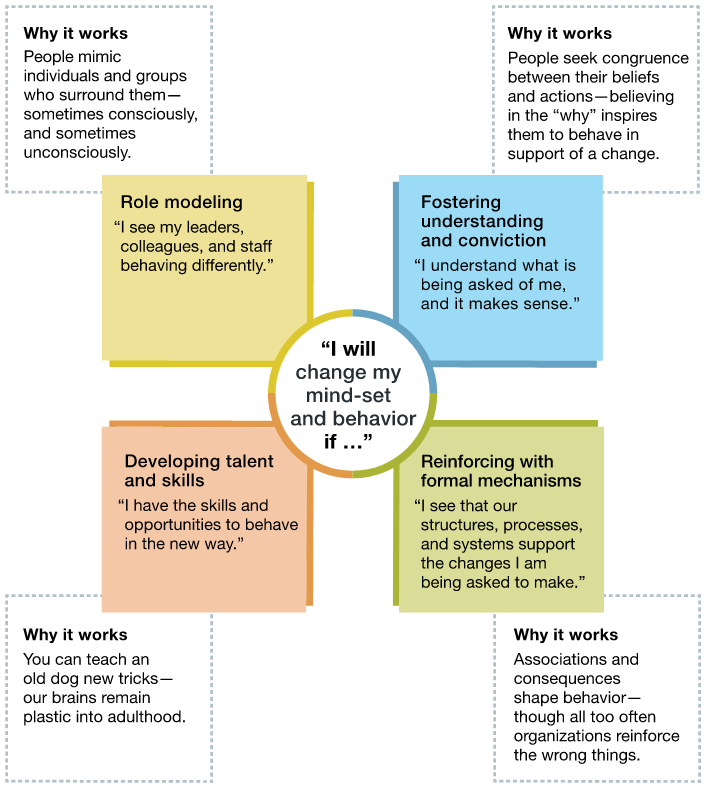 For change to be carried out under optimal conditions, it must influence a series of attitude changes in the workforce to ensure that it is carried out successfully, both individually and collectively.
For change to be carried out under optimal conditions, it must influence a series of attitude changes in the workforce to ensure that it is carried out successfully, both individually and collectively.
However, it may be complex to produce changes in business organisations and its working methodologies, both in large and small corporations.
Some studies indicate that approximately 70% of attempted company change or transformation end in failure. This is not surprising, because human beings, by nature, are conformist and tend to be resistant to change.
According to a 2016 study by consulting firm McKinsey, there are four building blocks that determine the influence on employee behaviour.
All the models focus in the mindset of the worker and assume that the worker will accept the change if he observes or finds positive attitudes around his or her working environment. Therefore, the exposition of each of the attitudes will begin by articulating a phrase that summarises the worker's feeling towards them. Below, we will analyze why each of the attitudes work.

Role Modelling
"I observe that my colleagues, leaders, and in general the whole team behave differently."
This theory works because people tend to imitate the attitudes of a group and to integrate within it, both consciously and unconsciously.
If the whole team behaves in a certain way, the tendency is that all workers try to adopt the same attitudes to blend in.
All new members will be conscious of the active working model and, therefore, will adopt it immediately.
Knowledge, understanding and conviction
"I understand what is being asked of me and it makes sense to me"
In a company, or in any other organization, there are critical voices, and they must always exist. They are necessary for both individual and collective growth.
However, both criticisms as well as the adoption of collective standards, especially among highly qualified teams, should not be destructive but constructive. In this way, the company can present a certain flexibility to adapt to the specific needs and methodologies of each of its employees.
At the same time, as they are rules that are not completely imposed, but are collectively established, understood and accepted by all workers, compliance is guaranteed.
The worker should not understand the new methodologies of work as an imposition but as a necessity that makes his work more productive and efficient.
Development of talents and abilities
"I have the skills, the talent and the opportunity to adopt the new working methodologies."
In order to adopt new working methodologies, firstly, it is necessary to learn to use them from a theoretical point of view and then proceed to a practical tutored period. To do this, the company must conceive the adoption of new work methodologies and new project management systems as an investment for the future. After all, the work, products or services developed by the company are channelled through projects, so working on their optimization means facilitating the success of the company as a whole.
In addition to the worker feeling that what is good for the company is good for him, he must also feel accompanied and guided during the process of change. Therefore, it is necessary to teach already established workers to adopt to the new working methodologies.
Reinforcement of adopted attitudes
"I note that structures, processes, and systems support the change that is required of me."
The dissonance between the demands of behavioural change and the infrastructure of technology and methodologies can definitely inhibit not only motivation for change, but the employee's own commitment to the organization and leadership. On the other hand, if the employee is able to see that the required change is not only a necessary consequence of the organization's processes, but that its new behaviour is prolonged and supported by those same processes, leadership will be perceived as responsible, considerate and capable to take into account all the details.
If workers observe, feel, and understand that change leads to a more successful business and that this is beneficial to them, they will be happy to continue adopting new work systems. Therefore, the greater productivity achieved through change must be transferred to their daily work and demonstrated through data and also through improvements in their daily lives.
